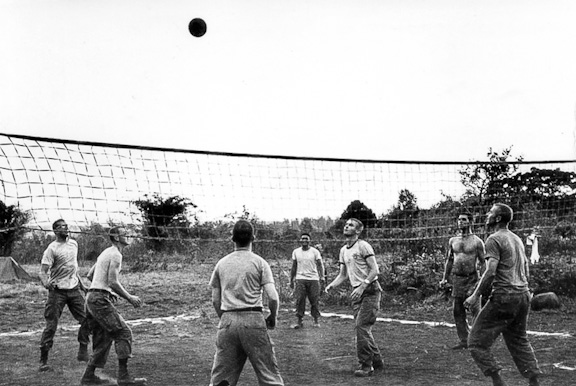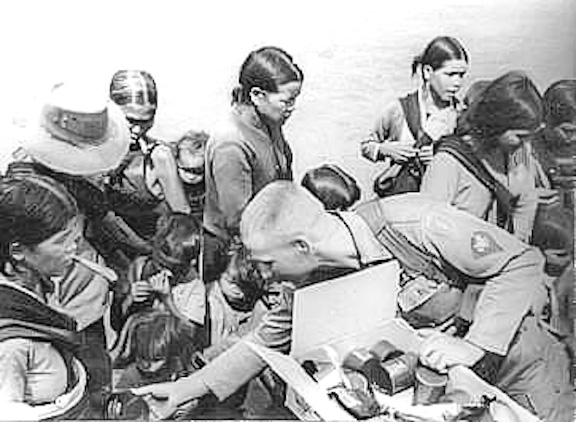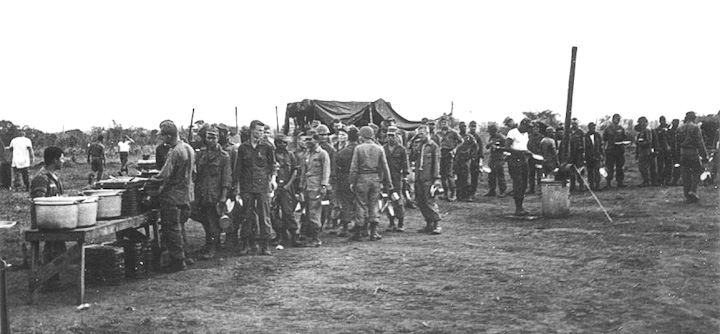
HOME
1/14th
Daily Journal for APRIL 1966.
*Grid coordinates for LZ 11 and LZ 14, April 1-7, obtained from 2/29th
Artillery
Operation Lincoln After Action Report
1 APRIL 1966 from Due Co. the battalion was to distinguish itself in Operation "Lincoln". This commitment placed the battalion next to the 1st Cav. Operating to the east and south of the Chu Pong Mountain Complex. Co. B conducted a combat assault to LZ 11 (*YA802080) southwest of Due Co. at about 1000 hours. Fire was immediately received and returned. The enemy fled in a westerly direction pursued by Battling Bravo. Following B Co. was C Co., the Command group and the artillery. After all elements had closed C Co. and the artillery started preparing the perimeter.
About 1000 meters to the west B Co. started receiving heavy automatic fire from a bunker complex on their left flank. Lt. Richard Rand, a staff officer accompanying B Co. was killed instantly and three other men in the company were wounded. The complex was well concealed in very thick brush. Captain Richard A Barry directed very effective ground and air support on the well entrenched enemy. B Co. killed four of the NVA soldiers and then brought back the wounded to LZ 11 where the medevac chopper was waiting. B Co. moved into the perimeter, her troops exhausted from wrestling with an enemy which proved itself rough and ready.
2 APRIL 1966 once again B Co. sent out platoon patrols in the vicinity of the bunker complex. Once again heavy effective fire was received by the entrenched enemy forces. Still the enemy positions proved impregnable to ground troops and once again massive ground and air suppressive fires were used. Meanwhile C Co. moved south of the Ia Drang up to hill 383 (grid coordinates 809055 on Sheet 6551 IV). After screening the mountain top and finding a small base camp they set up a defensive perimeter at an LZ on the northern base of the hill. B Co. patrols moved back to LZ 11, the results of their combat unknown. This type of hard core well entrenched enemy is something we must expect – when we hit him in his prepared hole we must expect the sometimes he will prove determined. If so we must use the air and ground support that is available to us as Captain Barry proved in both engagements. The night settled and no contact was made.
3 APRIL 1966 at 0015, under the cover of darkness, the enemy hit LZ 11 with about 60 82 mm mortar rounds. Both artillery and our own mortar platoons reacted and tried to locate the enemy fire. We had 15 men wounded during the heavy barrage. The wounded were immediately evacuated. Once again, deep foxholes proved themselves invaluable to the men. In the light of morning a tank Co., Co. B, and the battalion command group with the A Battery 2/9 artillery moved to LZ 14 (*YA816095) located northeast of LZ 11. The new LZ had a heavy wood line skirting the perimeter with the newly formed tank trail running SW-NE on its southern side. As one can guess we had armor attached to us for the first time. Captain Richard Russell of the 69th Armor brought his company of 16 monsters crashing through the thick foliage blazing his own trail from Due Co. They originally met us at LZ 11. Co. C also received 2 platoons of tanks. The armor crossed the Ia Drang with ease and settled in the C Company’s LZ. No contact was reported during the night.
4 APRIL 1966 at daylight all units were broken down into blocking positions covering the east-west approaches to and from the border, located a minimum of 3,000 meters from any one unit. C Company with its platoon of tanks was located south of the Ia Drang with 4 blocking positions. B Co. and A Co. were located north of the Ia Drang. A Co. had positions south of the river linking up with C Co.’s right flank. B and A Co.’s were in similar positions, each having four blocking positions supported by armor.
5 APRIL 1966 Co. B started the morning activities by sending a platoon of riflemen plus a platoon of tanks over to the bunker positions to their southwest. Two of the rifle squads started to receive fire while the tanks tried desperately to cross the creek bed running north and south in front of the bunkers. However, their efforts were in vain and they were unable to do so. However, one NVA soldier came in the sights of one of the tanks and it unloaded one of its 90 mm canister round. Needless to say one less enemy soldier would plague the Dragons. B Co. once again called in artillery that scored for 3 more of the enemy dead while gunships from up top came in on a low level flight and with their suppressive fires tallied for 6 more NVA soldiers. After the withdrawal of the armor and a job well done the troops moved back to their LZ. Thus the myth of the once impregnable bunkers was slowly coming to an end. All other units had no contact during the day or falling of darkness.
6 APRIL 1966 the day was concerned with the blocking forces of all units withdrawing to LZ 14. About 1000 hours when C Co. was withdrawing its two southern blocking forces, two of the attached tanks hit mines that had been implanted early that morning by the enemy. When the 2nd tank hit the mine and lost one of its tracks a sniper close by started to fire at the riding infantry troops. The tank whirled its turret and with its co-axial 7.62 knocked him out of the trees. After the maintenance track went out to retrieve the wounded vehicles they were repaired and C Co. departed for LZ 14 (*YA816095) by about 1630 and closed into the LZ about 1730. The perimeter was rapidly established and the troops plus two platoons of armor settled in for a night of peace and quiet.
7 APRIL 1966 this day concerned itself with the termination of Operation "Lincoln". A Co. and B Co. plus the Battalion command group left by chopper from LZ 14 to Due Co. and C Co. rode in with the armor. Some of the troops were amazed by the power of the hulking machines crashing through thick bamboo and moving up steep inclines. When all units had reached Due Co. the trains moved by vehicles back to base camp while the troops were loaded on Caribou aircraft on the airstrip and flown back to New Plieku airstrip where the troops off-loaded and were picked up by bus and brought back to tent city. The entire battalion closed in to base camp by about 1700 hours. "Boy, has this joint changed!"
8 APRIL 1966—11 APRIL 1966
all units of the Dragons were now in from a 43-day operation, which had
taken place during the dry season. The area the Dragons had covered, about
700 miles of just about any type terrain one could find in the central
highlands of Vietnam. Other than manning a portion of the perimeter, rest,
equipment cleaning and recreation was the order of the four
days to follow. The range was used by all units to re-zero their weapons and
practice firing of their LAWS. Much of the recreational equipment was
unpacked and volleyball and horseshoes caused cases of beer to switch hands
throughout the battalion.

From left: Cpt. Jackson, Lt. Rasor,Cpt. Cacioppe, Unknown, Cpt. Berry, Lt.
Kukea, Ltc. Proctor
12 APRIL 1966 at 0700 hours the Battalion moved out once again to provide road-guard for the invaluable supply-bearing convoys moving from Quin Nhon to Pleiku. Although the men felt misused during its first road clearing mission, this time it was a welcomed task after forty-three days of search and destroy type missions. All elements of the unit were in position by 1400 hours, and the 2nd Battalion, 35th Infantry moved back to Pleiku after almost 45 days of guarding a portion of route 19. The Batalion CP was located atop of Mang Yang pass. This location was the once proposed site for Madam Ngu’s summer resort. On top of the pass one could see to the east as far as Quin Nhon itself. Also at the bottom of the pass one could observe the remnants of the famous ambush of Mang Yang Pass by the Viet Mihn against the French. With the men in position, afternoon convoys roared through the sector. At 1:00 the road was closed and the troops were pulled into a tight company perimeter. The night was quiet.
13 APRIL 1966 after the troops were in position and the road was opened, Lt. Thomas Jones via M-23 went to An Khe for a briefing on the enemy situation in the area. After returning he informed Colonel Procter that a VC company of one hundred and fifty men had been spotted yesterday at coord. BR 380395 and also at BR 330400 following the stream that ran north-northeast of the highway. Lt. Jones believed, as did Major Evrard, that they would try to stop traffic to get foodstuffs and money as had been their tactics in the area. Three platoon size ambush teams were sent out, covering likely avenues of approach. The enemy force was believed to be carrying seven automatic rifles, 1-60 mm mortar, and several small arms weapons. However, negative contact was made with the enemy force.
14 APRIL 1966 at 0735 all elements of the unit were in position and the road was opened. The day started with clear skies and the early hours of the day became extremely hot. At 1345 hours, Sergeant Edward Korstman, of the recon platoon, received fire from a group of unknown snipers. Lt. Richard Beal immediately suspected the nearby ARVN troops of this mishap. Along with an interpreter, Lt. Beal questioned the troops who, as usual, claimed to know nothing of the incident.
General Glenn D. Walker visited Colonel Procter and they discussed progress and future tactical planning. After closing the road, the troops pulled into their company bases. Hot A rations were severed for the night meal and the night proved to be a quiet one.
15 APRIL 1966 the morning brought with it clear skies and a comfortable breeze. At 0735, all elements had departed their company base of operations and were maintaining their positions by the highway. After the men had settled in position, the 1st Air Cav., to the east of our sector, reported receiving sniper fire. Recon planes were dispatched to the area requested, but, however, were unable to locate the elusive enemy. Elements of C Company reported two ARVN drives coming through the sector in a seemingly reckless manner. They were driving abreast of one another and seemed to be racing at terrific speeds. An MP vehicle was sent to stop these maniacs, however, they arrived only in time to pick up the pieces. The vehicle had overturned at a sharp corner in the road and both drivers were evacuated.
During the late hours of the day, Captain Richard Barry reported that his left flank was receiving sniper fire. Artillery was called in to convince the enemy this was not a healthy sport. After the rounds poured into the area, the sniper fire, needless to say, ceased. Soon the troops were brought back to their company perimeters, the road closed and the night was quiet.
16 APRIL 1966 after the Golden Dragons opened the highway, each element received two two and one-half ton trucks to cut logs for their bunkers back at base camp. The Colonel decided that since they had the time the men could get logs which were unavailable back at the base camp area. Also, a specified number of men were sent back to base camp to work on those bunkers to distribute the workload.
To offset the decrease in manpower the 69th Armor dispatched a platoon of tanks to fill the gaps in the security mission and also helped guard the log cutting details. The tanks also put on a firing demonstration on the base of a hill, which impressed all spectators.
17 APRIL 1966-5 MAY
the road mission continued through these above dates. We had two special
visitors – the first being Col. Hal Moore of the 3rd Bde, 1st
Cav. Col. Procter and Col. Moore discussed the enemy situation of the area
and the probable areas of future deployment. The following day Lt. Cmdr.
William E. Evrard, of the 2nd Coastal District (Advisory Team
35), Nha Trang paid his brother Major James A. Evrard a visit.

Also during this period, our civil affairs program was put into high gear.
The several villages that lines our sector were give a regular sick call by
our Battalion Surgeon, Dr. Clark, and a great quantity of soap and other
necessities were donated by the Golden Dragons. We used interpreters
extensively and Captain Beal found himself extremely busy with the many
tasks these areas required. The program was extremely successful in one of
three Leper villages in the area.
Another highlight during this period was the "Red Berets" of the 23 Ranger Battalion of Pleiku that sent patrols throughout our sector. Some of the Dragons accompanied their patrols and considered them extremely proficient.
Guarding Route 19 had its dangerous aspects. Besides the ever-present possibility of enemy action, the driving habits of our Vietnamese allies were a hazard to life and limb.
On 24 APRIL 1966 at 1900 hours, Captain Charles Jackson, the Artillery LNO attached to the Golden Dragons, had a significant contact. While driving on Route 19, Captain Jackson and his driver, heading west met two water buffalo heading east. Both Captain Jackson and his driver, PFC Fink were injured and their jeep was demolished. One water buffalo was KIA, dying of its wounds some time later. Both water buffalo were eaten by the Montagnards in the area. Captain Jackson and PFC Fink, however, escaped to the hospital. The jeep was a total wreck.
In the late hours of May 5, the Dragons move back
to base camp after 25 days of a clearing, securing, and guarding mission on
route 19.

B Company Mess Line
A constant stream of little stray Lambrettas bearing the feminine charms of Vietnam caused traffic problems, distractions, and VD along the route. The problem of "clearing the highway" was neatly solved by Capt. C. L. Ross of Alpha Army, who simply shot the tire of the "___________ central" Lambretta. Exit the VD problem, stage right.
Guarding route 19 was an experience for the Golden Dragons. Route 19 west of An Khe was stuffed with the fragments of old equipment and the cars of old battles. The thought of the ill-fated march of the French G.M. 100 is a sobering one, and that road, serene and calm by day, is haunted by the ghosts of gallant men who gave their lives along its way. Yet the echoed thunder of old battles, and the remembrance of brave men how died did not affect the men of the Golden Dragons badly. Instead, they were inspired by the gallantry of those who had gone before, and many a man swore a private vow to continue to fight.
